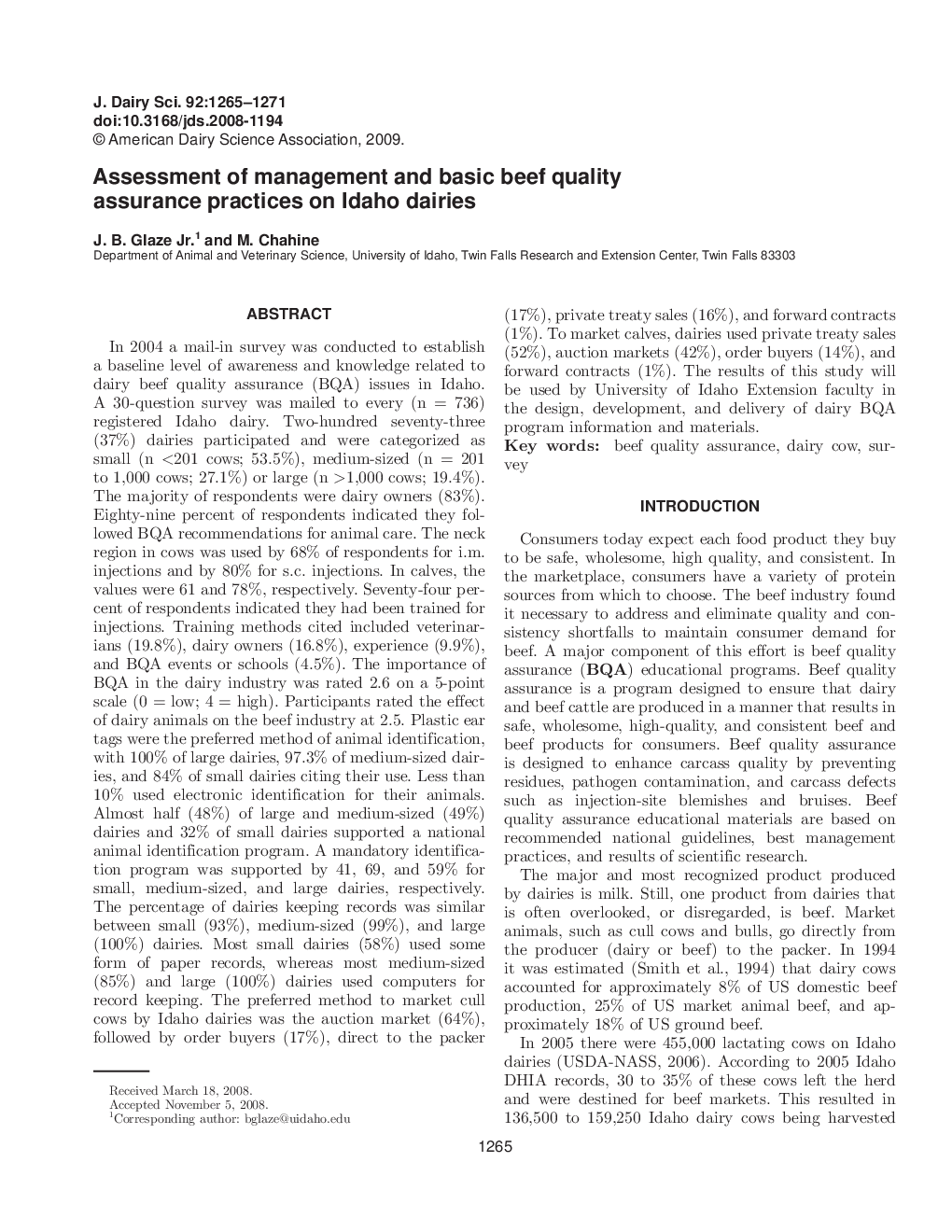| کد مقاله | کد نشریه | سال انتشار | مقاله انگلیسی | نسخه تمام متن |
|---|---|---|---|---|
| 2439881 | 1108106 | 2009 | 7 صفحه PDF | دانلود رایگان |
عنوان انگلیسی مقاله ISI
Assessment of management and basic beef quality assurance practices on Idaho dairies
دانلود مقاله + سفارش ترجمه
دانلود مقاله ISI انگلیسی
رایگان برای ایرانیان
موضوعات مرتبط
علوم زیستی و بیوفناوری
علوم کشاورزی و بیولوژیک
علوم دامی و جانورشناسی
پیش نمایش صفحه اول مقاله

چکیده انگلیسی
In 2004 a mail-in survey was conducted to establish a baseline level of awareness and knowledge related to dairy beef quality assurance (BQA) issues in Idaho. A 30-question survey was mailed to every (n = 736) registered Idaho dairy. Two-hundred seventy-three (37%) dairies participated and were categorized as small (n <201 cows; 53.5%), medium-sized (n = 201 to 1,000 cows; 27.1%) or large (n >1,000 cows; 19.4%). The majority of respondents were dairy owners (83%). Eighty-nine percent of respondents indicated they followed BQA recommendations for animal care. The neck region in cows was used by 68% of respondents for i.m. injections and by 80% for s.c. injections. In calves, the values were 61 and 78%, respectively. Seventy-four percent of respondents indicated they had been trained for injections. Training methods cited included veterinarians (19.8%), dairy owners (16.8%), experience (9.9%), and BQA events or schools (4.5%). The importance of BQA in the dairy industry was rated 2.6 on a 5-point scale (0 = low; 4 = high). Participants rated the effect of dairy animals on the beef industry at 2.5. Plastic ear tags were the preferred method of animal identification, with 100% of large dairies, 97.3% of medium-sized dairies, and 84% of small dairies citing their use. Less than 10% used electronic identification for their animals. Almost half (48%) of large and medium-sized (49%) dairies and 32% of small dairies supported a national animal identification program. A mandatory identification program was supported by 41, 69, and 59% for small, medium-sized, and large dairies, respectively. The percentage of dairies keeping records was similar between small (93%), medium-sized (99%), and large (100%) dairies. Most small dairies (58%) used some form of paper records, whereas most medium-sized (85%) and large (100%) dairies used computers for record keeping. The preferred method to market cull cows by Idaho dairies was the auction market (64%), followed by order buyers (17%), direct to the packer (17%), private treaty sales (16%), and forward contracts (1%). To market calves, dairies used private treaty sales (52%), auction markets (42%), order buyers (14%), and forward contracts (1%). The results of this study will be used by University of Idaho Extension faculty in the design, development, and delivery of dairy BQA program information and materials.
ناشر
Database: Elsevier - ScienceDirect (ساینس دایرکت)
Journal: Journal of Dairy Science - Volume 92, Issue 3, March 2009, Pages 1265-1271
Journal: Journal of Dairy Science - Volume 92, Issue 3, March 2009, Pages 1265-1271
نویسندگان
J.B. Jr., M. Chahine,